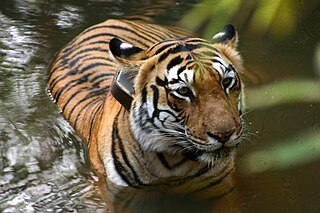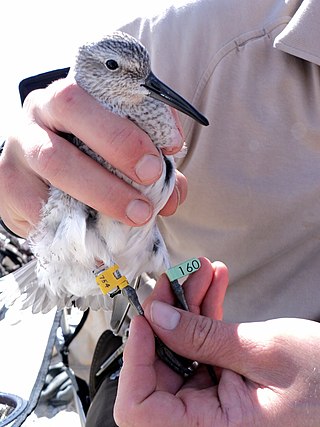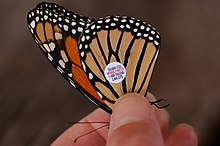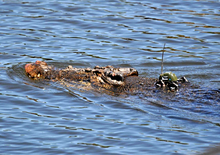
Telemetry is the in situ collection of measurements or other data at remote points and their automatic transmission to receiving equipment (telecommunication) for monitoring. The word is derived from the Greek roots tele, 'remote', and metron, 'measure'. Systems that need external instructions and data to operate require the counterpart of telemetry: telecommand.

Bird ringing (UK) or bird banding (US) is the attachment of a small, individually numbered metal or plastic tag to the leg or wing of a wild bird to enable individual identification. This helps in keeping track of the movements of the bird and its life history. It is common to take measurements and examine conditions of feather molt, subcutaneous fat, age indications and sex during capture for ringing. The subsequent recapture or recovery of the bird can provide information on migration, longevity, mortality, population, territoriality, feeding behavior, and other aspects that are studied by ornithologists. Other methods of marking birds may also be used to allow for field based identification that does not require capture.
Automatic vehicle location is a means for automatically determining and transmitting the geographic location of a vehicle. This vehicle location data, from one or more vehicles, may then be collected by a vehicle tracking system to manage an overview of vehicle travel. As of 2017, GPS technology has reached the point of having the transmitting device be smaller than the size of a human thumb, able to run 6 months or more between battery charges, easy to communicate with smartphones — all for less than $20 USD.
Passive radar is a class of radar systems that detect and track objects by processing reflections from non-cooperative sources of illumination in the environment, such as commercial broadcast and communications signals. It is a specific case of bistatic radar – passive bistatic radar (PBR) – which is a broad type also including the exploitation of cooperative and non-cooperative radar transmitters.
Biotelemetry involves the application of telemetry in biology, medicine, and other health care to remotely monitor various vital signs of ambulatory patients.
Acoustic tags are small sound-emitting devices that allow the detection and/or remote tracking of organisms in aquatic ecosystems. Acoustic tags are commonly used to monitor the behavior of fish. Studies can be conducted in lakes, rivers, tributaries, estuaries or at sea. Acoustic tag technology allows researchers to obtain locational data of tagged fish: depending on tag and receiver array configurations, researchers can receive simple presence/absence data, 2D positional data, or even 3D fish tracks in real-time with sub-meter resolutions.

Animal migration is the relatively long-distance movement of individual animals, usually on a seasonal basis. It is the most common form of migration in ecology. It is found in all major animal groups, including birds, mammals, fish, reptiles, amphibians, insects, and crustaceans. The cause of migration may be local climate, local availability of food, the season of the year or for mating.

GPS animal tracking is a process whereby biologists, scientific researchers, or conservation agencies can remotely observe relatively fine-scale movement or migratory patterns in a free-ranging wild animal using the Global Positioning System (GPS) and optional environmental sensors or automated data-retrieval technologies such as Argos satellite uplink, mobile data telephony or GPRS and a range of analytical software tools.

Radio is the technology of communicating using radio waves. Radio waves are electromagnetic waves of frequency between 3 hertz (Hz) and 300 gigahertz (GHz). They are generated by an electronic device called a transmitter connected to an antenna which radiates the waves. They are received by another antenna connected to a radio receiver. In addition to communication, radio is used for radar, radio navigation, remote control, remote sensing, and other applications.

Geographic Information Systems (GIS) has become an integral part of aquatic science and limnology. Water by its very nature is dynamic. Features associated with water are thus ever-changing. To be able to keep up with these changes, technological advancements have given scientists methods to enhance all aspects of scientific investigation, from satellite tracking of wildlife to computer mapping of habitats. Agencies like the US Geological Survey, US Fish and Wildlife Service as well as other federal and state agencies are utilizing GIS to aid in their conservation efforts.

Pop-up satellite archival tags (PSATs) are used to track movements of marine animals. A PSAT is an archival tag that is equipped with a means to transmit the collected data via the Argos satellite system. Though the data are physically stored on the tag, its major advantage is that it does not have to be physically retrieved like an archival tag for the data to be available making it a viable, fishery independent tool for animal behavior and migration studies. They have been used to track movements of ocean sunfish, marlin, blue sharks, bluefin tuna, swordfish and sea turtles to name a few species. Location, depth, temperature, oxygen levels, and body movement data are used to answer questions about migratory patterns, seasonal feeding movements, daily habits, and survival after catch and release, for examples.
A data storage tag (DST), also sometimes known as an archival tag, is a combination of a data logger and multiple sensors that record data at predetermined intervals. DSTs usually have a large memory size and a long lifetime: most are supported by batteries that allow the tag to record positions for several years. Alternatively some tags are solar powered and allow the scientist to set their own interval; this then allows data to be recorded for significantly longer than battery-only powered tags.
Tour de Turtles: A Sea Turtle Migration Marathon, or simply Tour de Turtles, is an annual online migration-tracking event hosted by the Caribbean Conservation Corporation. Endangered sea turtles are monitored using an attached but harmless satellite tracking device. Caribbean Conservation Corporation biologists gather satellite tracking information in order to better understand sea turtle migration patterns. Understanding sea turtle migration patterns would allow for sea turtle conservation groups to lobby for more sea turtle protection in proven areas with higher sea turtle populations. Sea turtles are the participants for the Tour de Turtle marathon. Participating sea turtles are tracked as they race to be the first to complete a 2,620-kilometre (1,628 mi) journey that is estimated to last three months. Tour de Turtles aims to increase awareness about different sea turtle species and the threats to their survival. The turtle to first swim the 1,628 miles wins the marathon.

A light level geolocator, light-level logger or global location sensor (GLS) is a lightweight, electronic archival tracking device, usually used in bird migration research to map migration routes, identify important staging areas, and sometimes provide additional ecological information. A geolocator periodically records ambient light level to determine location.

An RF module is a (usually) small electronic device used to transmit and/or receive radio signals between two devices. In an embedded system it is often desirable to communicate with another device wirelessly. This wireless communication may be accomplished through optical communication or through radio-frequency (RF) communication. For many applications, the medium of choice is RF since it does not require line of sight. RF communications incorporate a transmitter and a receiver. They are of various types and ranges. Some can transmit up to 500 feet. RF modules are typically fabricated using RF CMOS technology.
The history of wildlife tracking technology involves the evolution of technologies that have been used to monitor, track, and locate many different types of wildlife. Many individuals have an interest in tracking wildlife, including biologists, scientific researchers, and conservationists. Biotelemetry is "the instrumental technique for gaining and transmitting information from a living organism and its environment to a remote observer".

The ICARUS Initiative, short for International Cooperation for Animal Research Using Space, is an international effort to track the migratory patterns of small flying animals using radio transmitters. The project began in 2002 and the tracking system was installed on the International Space Station (ISS) in August 2018, switched on in July 2019, and began operations in September 2020. The director for the ICARUS project is Martin Wikelski, director of the Max Planck Institute of Animal Behavior in Radolfzell, Germany.

A coded wire tag (CWT) is an animal tagging device, most often used for identifying batches of fish. It consists of a length of magnetized stainless steel wire 0.25 mm in diameter and typically 1.1 mm long. The tag is marked with rows of numbers denoting specific batch or individual codes. The tag is usually injected into the snout or cheek of a fish so that it may be tracked for research or fisheries management.

Wildlife radio telemetry is a tool used to track the movement and behavior of animals. This technique uses the transmission of radio signals to locate a transmitter attached to the animal of interest. It is often used to obtain location data on the animal's preferred habitat, home range, and to understand population dynamics. The different types of radio telemetry techniques include very high frequency (VHF) transmitters, global positioning system (GPS) tracking, and satellite tracking. Recent advances in technology have improved radio telemetry techniques by increasing the efficacy of data collection. However, studies involving radio telemetry should be reviewed in order to determine if newer techniques, such as collars that transmit the location to the operator via satellites, are actually required to accomplish the goals of the study.

Motus is a network of radio receivers for tracking signals from transmitters attached to wild animals. Motus uses radio telemetry for real-time tracking. It was launched by Birds Canada in 2014 in the US and Canada.




















